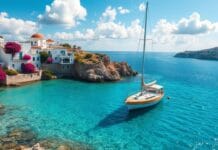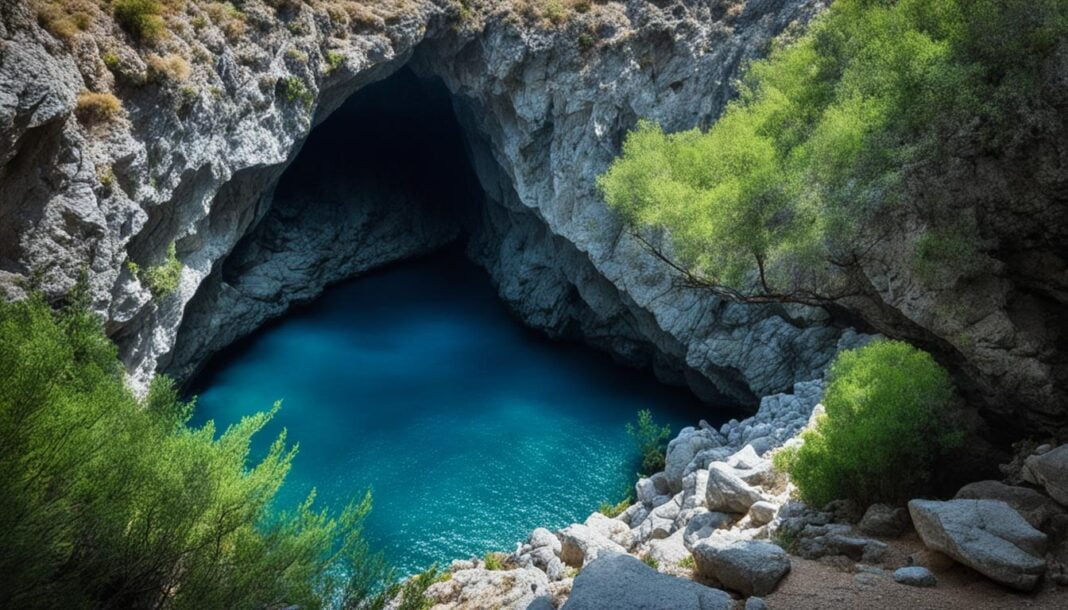Have you ever been drawn to ancient myths and stories? I love Greek mythology and find the tales of Crete especially rich. The island’s myths about minotaurs, labyrinths, and powerful gods have been shared for ages. They feed our imaginations and are a big part of our culture. The myth of Crete brings us to a place where gods, heroes, and legends are real.
One story from Crete is about King Minos and the Minotaur. King Minos upset the gods and was punished with a terrible creature, the Minotaur. This beast lived in a huge and confusing labyrinth. This maze was so tricky that anyone who went in got lost.
Every year, seven young people from Athens were sent to be food for the Minotaur. But one year, an Athenian prince named Theseus decided to fight the monster. With the help of a princess, he used a thread to guide him in and out of the labyrinth. He defeated the Minotaur and escaped, showing how bravery and smarts can beat any challenge.
But Crete’s myths go beyond the Minotaur. The island is also the birthplace of Zeus, the king of the gods. He was born in a sacred cave, starting a legacy of power and wisdom that still influences us today. Crete is not just a place for stories. It’s a key part of Greek mythology, showing its deep connection to ancient beliefs.
Crete’s myths continue to fascinate and intrigue us. Stories of minotaurs and gods help us appreciate the island’s long history. It was once home to a great civilization and later saw many changes. Even now, its caves and other sites remind us of its legendary past.
History of Crete in ancient times
In ancient times, Crete was the heart of the Minoan civilization. This was one of the world’s top civilizations. It had grand palaces, like the famous Knossos Palace1. These palaces showed their amazing architecture and art.
But, a volcanic eruption on Santorini1 caused a disaster. It made big waves and destroyed parts of northern Crete.
After the eruption, the Minoans faced new enemies. The Achaeans and Dorians, tribes from the north, invaded. This changed Crete’s history forever1.
Despite the attack, ancient Minoan towns still exist in Crete. Knossos, especially, is very well-preserved2.
Crete has seen many rulers over the years. It’s been home to people since around 130,000 years ago1. The Minoans, starting about 7,000 years ago, were Europe’s first big civilization1.
They had a great navigation system for trade. This made Minoan Crete wealthy and innovative. They even made the first writing system, Linear A2.
After Minoans, Crete had a hard time with conflicts and wars. In the late 4th century BC, Greek city-states rose on the island1. Knossos had competition from cities like Gortyn during the Hellenistic period1.
Later, the Romans took over Crete after a three-year war1. Gortyn became the capital of a Roman province. But soon, others ruled over the island, including Andalusian Muslims and the Byzantines in 961 CE1.
Venetians ruled Crete from 1205 to 1669. Then, the Ottomans took control1. Today, we can see Minoan artifacts in the Archaeological Museum of Heraklion2.
Venetian and Ottoman occupation of Crete
Crete has a long and varied history. It saw the power of the Arabs, Venetians, and Ottomans. The Venetian and Ottoman times were especially important. They changed the island’s culture, buildings, and politics.
From 1204 to 1669, Crete was under Venetian rule. This brought a time of wealth and culture. The Venetians built strong cities, like the famous Candia. Their architecture still shapes Crete today3. Many Orthodox churches from that time show the Venetian style3. The painter El Greco also started his work in this period4.
The Ottomans took over Crete in 1669 after a big war4. Their rule lasted for 229 years. They changed Crete’s culture and politics. Chania became a key trading city under the Ottomans3. People fought against the Ottomans because of bad taxes and working conditions. A famous battle, the revolt at the Arkadi monastery in 1866, shows Crete’s fight for freedom3.
In 1898, Crete broke free from the Ottomans. It then was under international care. Finally, in 1913, Crete joined Greece3. The Ottomans and Venetians made big and lasting changes to Crete. But they also helped shape its special mix of cultures and its tough history.
El Greco and his Influence on Cretan Art
El Greco, born in Crete in 1541, was a top painter. He learned in the Cretan School of painting. This school was supported by the Venetians4. El Greco mixed many styles in his art. His use of color and shape is very unique4. His art is loved worldwide and is a great part of Crete’s culture.
The Venetian and Ottoman times were very important for Crete. They changed the island forever. Learning about these times helps us understand what makes Crete so special.
Conclusion
Today, Crete is a lively island known for farming, and tourism. It holds tight to its long ago tales and roots. These old stories, from over 2,000 years back, have caught the minds of many. They have not just entertained but also shaped the beliefs of the Greeks. Crete has been a key player since ancient times. It highlighted powerful female gods in its art. They stood for different things like power, honor, making life, and having kids5. Stories about King Minos, son to Zeus, and his child Ariadne add more to the island’s magical appeal5.
Zeus was close to heart in Crete. Legend has it, he was kept hidden in a cave as a baby. He was taken care of by nymphs and guarded by the Kouretes. This special place is on the Lassithi Plateau56. Inscriptions found at Palaikastro show ceremonies were held for boys in honor of Dictaian Zeus5.
In the past, Crete was thought to connect the East with the West. Its stories make it seem like a place full of hidden history and myths. There are talks in old Greek tales about robot-like beings. Some wonder if this shows a hint of advanced know-how not from this world5. The island is dotted with ancient spots and Minoan ruins from 2000-1100 BC. This mixture of old and new keeps many tourists coming. The Knossos site, outside Heraklion, is very popular. There’s also Phaistos and Malia to see6.
Crete blends its past with its today. This island truly shows the strength of its people. They have kept their ways alive while welcoming visitors and keeping up their crops. Today, Crete reminds us of its powerful stories and its key roles in both the old and new times567.





















